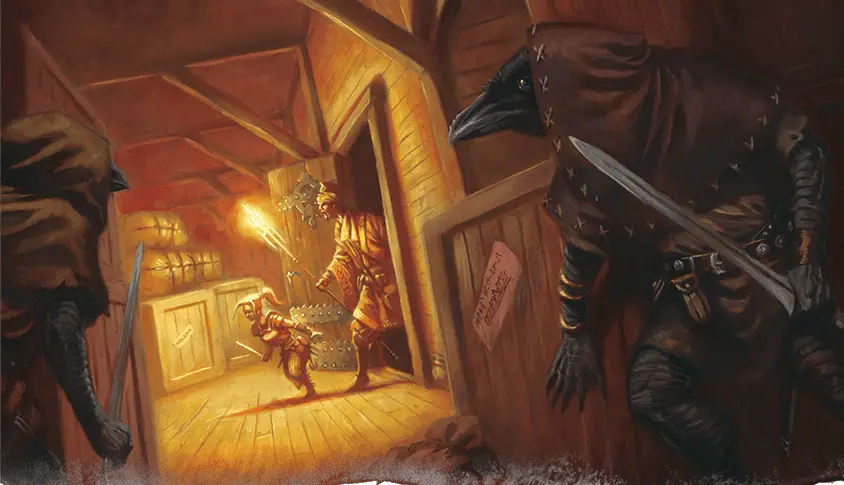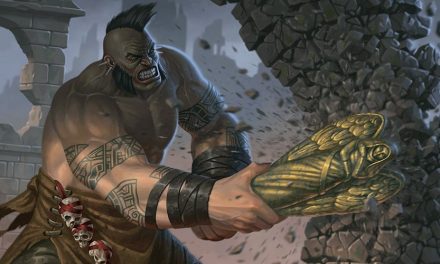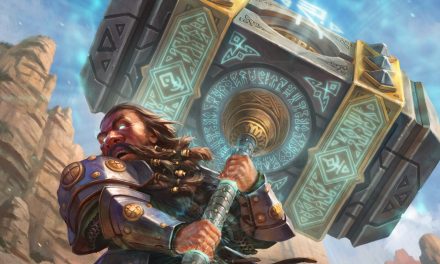Feats in D&D 5e are an excellent way to really bring your character concept to life within the game’s mechanics.
However, feats can often be a big point of confusion for players. Not only do you have to know when and how to get these abilities, but you also have to remember that you have them!
So today we’re going to take a closer look at how feats work in 5e to clear up any confusion that you might have!
This is the complete guide to Feats in D&D 5e!
What are Feats?
Starting at the top, let’s look at what feats actually are.
I think it’s best to look at feats as a type of expertise. Some, like the Great Weapon Master feat, might reflect special training that your character has had. Others might be the result of a more natural talent like the Keen Mind or Mobile feats.
Taking feats allows you to get extra abilities that you wouldn’t otherwise get. When you have a specific character concept in mind, feats are usually pretty important in making that happen!
After all, what archer could resist the Sharpshooter feat to make their shots even more lethal, increase their effective range, and render enemies’ partial cover useless?!
Players who particularly like to optimize their characters will rely fairly heavily on feats in most cases. That said, you don’t have to be an optimizer-type player to enjoy feats. Most of them are very cool and really add some new dimensions to your character both for game mechanics and roleplay!
Half-Feats
There are some feats that give you an extra ability while also increasing one of your abilities by 1. These are commonly known as “half-feats.”
Half-feats don’t typically have as game-changing of ability as “regular” feats. However, since you’ll usually have to choose between a +2 Ability Score Increase or a feat (more on this in a bit), it lets you get a bit of both.
This includes feats like Keen Mind (which still gives you a +1 to Intelligence) and Moderately Armored (which increases your Strength or Dexterity by 1.)
If you happen to have an ability score with an odd number, taking a “half-feat” can help you round that out to an even number. If you do that, you gain the abilities of the feat while also upping your skills with the ability that you just bumped up!
So, a wizard with a 17 Intelligence might be tempted to take the Keen Mind feat. This puts their Intelligence at 18, gives them a +4 modifier instead of a +3, AND makes them into a brainiac who can remember anything they’ve seen/heard within the last month.
How’s that for a buff?!
Gaining Feats in D&D 5e
Now that we’ve covered what feats are, let’s go over how you actually gain them.
Generally speaking, there are three primary ways to gain feats. We’ll look at each one individually!
Variant Human
In a world full of elves, dragons, dwarves, and other fantasy mainstays, you might wonder why someone would choose to be a human.
Even still, Humans tend to be one of the most popular picks! At the end of 2020, GeekNative asked D&D Beyond what the most popular race in 5e was on the platform and, sure enough, Humans topped the list!
I think the Variant Human option is absolutely the reason for that. In fact, I’d be willing to bet on it!
Until recently, if you wanted to gain a feat at level 1, the only way to do that RAW was to be a Variant Human.
The release of Tasha’s Cauldron of Everything shook that up a little bit by providing a framework for those who would prefer to make a custom lineage.
When using the rules for a Custom Lineage, you have the ability to also take a feat of your choice (that you qualify for) at character creation.
A Popular Homebrew Rule
A homebrew rule that I have seen more and more groups using these days allows everyone to take a feat at first level. In the case of Variant Humans or Custom Lineages, they get two.
I’m actually a fan of this rule. It helps people really bring out their character’s concept without making it feel like you have to compromise your vision too much.
Maybe you specifically want to play an Elf warrior who decimates enemies with a halberd. With this rule, you no longer have to decide between taking the Polearm Master feat or boosting your Strength score to make that happen and be effective.
Right from the beginning, you’re able to build the character that you specifically envision!
Leveling Up
Finally, we come to the “standard” method of gaining feats: leveling up.
As you level up, your character will be able to get an Ability Score Improvement (ASI) at certain levels. When you reach these levels, you can choose to take a feat instead of an Ability Score Improvement.
Most classes make this choice at levels 4, 8, 12, 16, and 19. Unless you got a feat at character creation for one of the reasons we covered above, you have 5 opportunities to gain feats.
Fighters tend to rely on feats more than most other classes, so they can choose between feats and an ASI at levels 4, 6, 8, 12, 14, 16, and 19.
ASI vs Feats
It’s a tough choice, right?
Feats are awesome and are pretty vital if you are wanting to narrow in your character’s expertise. However, by taking a feat you are missing out on the option to increase your ability scores.
This is what’s called “opportunity cost” and it can be tough!
Generally speaking, I think it’s worth it to go with the ASI in the early levels. Once my character’s primary ability score hits its cap at 20, then I’ll usually start looking at feats to take.
My reasoning is that this ability score powers most of what my character will be contributing to the party.
If I’m a Wizard, for example, I want my Spell Save DC to be as high as possible which means I want to invest pretty heavily in my Intelligence ability. When the fireballs start flying, I want as few enemies making their save as possible so I can deal some heavy damage!
However, I might sometimes make a slight exception to this practice.
Playing an archer, a feat like Sharpshooter just adds so much to the character. As I covered in my article about Ranged Combat in 5e, an archer wants to have as many positioning options open to them as possible. Removing the penalties for partial cover and increasing your effective range are great benefits to have!
If you’re playing a Fighter, it’s easier to bounce between taking the ASI and gaining feats. For other classes, it’s a tough choice but I would personally prioritize your primary abilities’ scores before taking feats!
Feat Restrictions and Requirements
Always make it a point to look over any requirements or restrictions for a feat that you’re considering!
Some won’t have any of these types of prerequisites like the Lucky or Observant feats. Others might require that you have a minimum score in an ability, have a certain proficiency, or be of a certain character race/lineage.
For example, to take the Defensive Duelist feat, you need to have a minimum Dexterity score of 13. For Rogues or Bards, this is no problem as this feat pretty easily fits those classes’ typical playstyles. Other classes might want to double-check their character sheet first!
Related: How to Read Your Character Sheet in D&D 5e
Meanwhile, the Heavily Armored feat allows you to become proficient in wearing heavy armor. The only catch is that you have to first have proficiency with medium armor to take this feat! Once you have proficiency with heavy armor, you then meet the requirement to take the Heavy Armor Master feat.
Lastly, some feats are reserved for characters of specific races/lineages. Most of these are found in Xanathar’s Guide to Everything and have the requirements included with each feat.
The Squat Nimbless feat, for example, is only available to Dwarves or races of a “small” size category like Gnomes or Halflings.
Dragonborn have the option of taking a Dragonborn-exclusive feat like Dragon Hide or Dragon Fear while Tieflings could take the Infernal Constitution feat.
What Feat Is Right For You?
There is no shortage of feat options in D&D 5e. It can be a little overwhelming trying to decide which one to take!
Feats are found in the Player’s Handbook on page 165, Xanathar’s Guide to Everything on page 73, and Tasha’s Cauldron of Everything on page 79.
The ideal situation is that you are making a character with a concept and suitable feats to make that happen in mind.
But if you’ve already made a character and are looking at taking feats to power them up, that’s ok too!
Choosing a Feat
You can start by disregarding feats that have prerequisites that your character doesn’t meet. Like we covered earlier, this might be certain ability scores, proficiencies, or character lineages that your character doesn’t have.
From there, consider your role in the party and what kind of bonuses would help you in that role.
If you typically keep your distance and fight with a bow, you won’t really get the benefits of feats like Dual Wielder which are more melee-focused. Instead, you might look at feats like Sharpshooter to make you more lethal at range or Alert to all but guarantee you’ll go first in most combats!
Because feats really help your character zero in on a specific type of role/expertise, you want to be aware of what role you’re already filling in the party!
Some Standout Feats
Ultimately, the best feats largely depend on what type of campaign you’re playing.
If you’re playing a campaign that’s all about exploring perilous dungeons in search of treasure, the Dungeon Delver feat is incredibly useful! If someone in the party has it, you’re less likely to miss secret doors or fall victim to some dastardly traps.
If you’re instead playing an adventure that doesn’t have as much dungeon-crawling, you’re not likely to get so much value out of this feat!
Knowing what type of adventure you’re going to be playing is important to making characters that can be heroes in that world. Nothing’s worse than taking a feat only to find that you never really get the chance to use it!
Related: That’s part of why I am such a strong advocate for having a Session Zero!
However, there are some feats that tend to stand out. While this isn’t going to be a comprehensive list, it should give you a starting point as you think about what kind of feats would suit your character!
Melee Combatants
Sentinel can make you a defensive powerhouse. Not only can you stop enemies in their tracks and punish them for attacking your allies, but you also become a master of opportunity attacks!
If you’re looking to bring some serious pain, Great Weapon Master can turn you into a destructive force of nature in combat. Not only can you gain some serious extra damage to your heavy weapon attacks, but you can also get extra attacks when you score a critical hit or drop an enemy to 0 hit points!
Archers
Sharpshooter is pretty much a must-have for ranged attack characters. Being able to ignore half and three-quarters cover while also making full use of your weapon’s range is fantastic as it is. Adding in the ability to potentially have your shots dealing an extra 10 damage makes this a wonderful pick!
If you’re going for a type of sniper character, Skulker can be a great choice. It makes it easier for you to hide and you aren’t at disadvantage due to dim light conditions. This feat is mostly useful as a “just in case” though. Missing a ranged attack while you’re hidden from a creature doesn’t reveal your position which can help you still land that sneak attack!
Casters
Quite possibly the single most important feat option for casters is War Caster. This gives you advantage to maintain concentration, lets you cast spells as an opportunity attack, and removes the need for you to perform somatic spell components. It’s simply fantastic!
Alert is another good option for casters. When your allies and enemies are all fighting in a big mass, it can be harder to get use out of big Area of Effect spells like Fireball or Cloudkill.
Not only will the Alert feat prevent you from being surprised, but the +5 to your initiative rolls can also help you go early in combat and drop some massive damage onto the field.
Roleplay
Inspiring Leader is a fantastic feat that high Charisma characters should consider. Being able to bolster your party with temporary hit points for the adventure ahead is wonderful.
For a campaign with lots of intrigue, you might like the Actor feat. If you’re a fan of using disguises and mimicking others, this can get you out of (and into!) a lot of trouble/fun!
General
It can be pretty useful to have a few spells up your sleeve and the Magic Initiate feat is great for that! You’ll gain two cantrips and a level 1 spell from your chosen class.
It can help casters pick up some spells that aren’t normally on their list just as well as it can help melee combatants grab spells that are well-suited to their role in the party. Spells like Shield or Booming Blade are great choices in those cases!
As enemies’ abilities get more punishing later in the game, feats like Resilient can be lifesavers! Resilient lets you add your proficiency to saves with your chosen ability. I’d personally recommend using this to boost your Constitution or Wisdom saving throws as effects requiring these saves can be brutal!
Last, but not least, we have the Lucky feat. This lets you reroll attack rolls, ability checks, and saving throws. It can also be used to mess up enemies’ attacks as well. Being able to do this three times a day is honestly a little broken, but I can’t say it’s not useful!
Conclusion – Explaining Feats in D&D 5e
So there you have it!
Hopefully, this guide has been able to clear up any confusion you might have about feats in D&D 5e! In the near future, I may do some breakdowns of recommended feats for each class. Let me know if that’s something you’d like to see!
Still have questions? Hit me up in the comments and I’m happy to help!
Got a favorite feat you’d like to recommend to others? Let us know!









